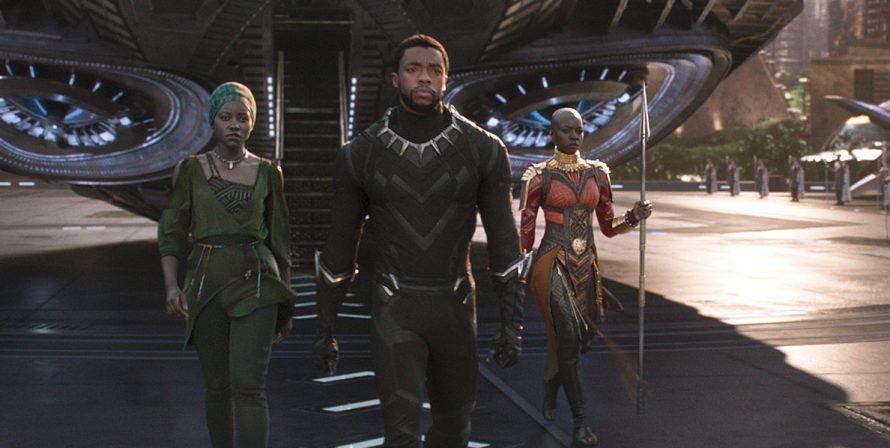There is something indescribable about Afrofuturism, something intangible. It is a visible utterance of Blackness, in all its hope and joy - and it almost always moves me to tears. The term was coined back in the nineties, and was originally used to describe a literary genre. Since then the Afrofuturist has found its way into film, art, and music; however, even before it had a name, Africa and its diaspora have been creating an Afrofuturist movement. Within, Blackness imagines itself in spaces and times and possibilities, both similar and dissimilar to our own.
Afrofuturism found itself in the mainstream with Ryan Coogler’s Black Panther (2018), showing as part of Welcome to the Afrofuture, at Glasgow Film Theatre. The Marvel hit depicts Wakanda, an African nation unreachable to the rest of the world, as its king T’Challa (Chadwick Boseman) is challenged by his estranged cousin Killmonger (Michael B Jordan). The programme also features Likarion Wainaina’s Supa Modo (2016), which follows Jo, a terminally-ill child, who’s dreams of being a superhero are made a (sort-of) reality, with the help of her big sister and her community. These two very different types of superheroes showcase simply a corner of the expanse of Afrofuturism within film.
While taking elements of science fiction and fantasy, these Afrofuturist narratives are grounded by their truthful depiction of the lives of Black Africans and the Black Diaspora. Black Panther incorporates traditional African mythology, Pan-African aesthetics, and languages such as Xhosa of South Africa. Its themes likewise speak to the African diaspora: the feelings of disconnect and detachment experienced by Killmonger are not unusual. For Supa Modo’s Jo, her illness is inescapable - and so too are the hardships which come with it, for her and her family. However, the community’s simultaneous grief and joy speaks to something within both Blackness and Afrofuturism: we may exist in multiple states of being, all at once. It is a necessary multiplicity forged through the realities of our past and present. This expanse of emotion plays into Afrofuturism’s ability to disregard the conventions created by the white lens. Too often, Blackness is on the silver screen to suffer for the sake of the story. The Black person dies first; the Black person is a thinly veiled stereotype; the Black person’s pain offers comic relief. But Afrofuturism refuses this sentencing. Through an Afrofuturist lens, Blackness manifests in hope and joy - both present and future focused.
But while Afrofuturist films are not the stuff of trauma porn, the pain of our communities is still recognised - and with that pain, comes fear. Afrofuturism does not resist fear: Wakanda is at risk, Jo is dying. Rather, Afrofuturism takes fear and uses it as a space in which hope may grow. Fear is not a failure, but an acceptance that joy - now, and in the future - exists, even if getting there scares us. The stakes are high but they are not out of reach. It is in these moments of reaching to the beyond that Afrofuturist films open up new possibilities: perhaps there is a way to die amid childhood joy; perhaps there is a place where Blackness is left unscathed by colonial powers. In both Supa Modo and Black Panther, we see communities truly connect and collect themselves with a care that is so closely tied to Blackness itself. It’s somewhat circular: Afrofuturism both inspires our communities and is inspired by said communities. Afrofuturism puts something unimaginable, and yet somehow imagined, on the table, and asks, "What if?" When we ask this of our films, we may also ask it of our own existence. Crafting a future for Blackness on screen makes it feel possible to craft a future for Blackness off screen. The Black imagination is not restricted to simply the imagination afterall.
Neither is Afrofuturism restricted to the strictly Afrofuturist either. The Afrofuturist movement extends beyond simply the films of its cannon. On truly connecting with the Afrofuturist, one begins to see its traces within on-screen Blackness in many genres. It’s in the jumping scenes of She’s Gotta Have It; it’s in the colour palette of Moonlight. These are not Afrofuturist films, but rather, films I now see the Afrofuturist within. Afrofuturism is not simply a film genre; it’s a way of understanding Blackness.
And so, Afrofuturism stays with you: it clings to you, and you to it. It is just as creatively radical as it is politically radical - and it is highly necessary. It’s necessary so that no matter how bleak things seem, for Wakanda, for Jo, or for ourselves, we can see our hope, our joy, and our futures. To move towards the Afrofuture is to both reach far from ourselves and, crucially, to reach within ourselves.
Part of Film Feels Hopeful, Glasgow Film Theatre's Welcome to the Afrofuture programme takes place between 21-26 August.


